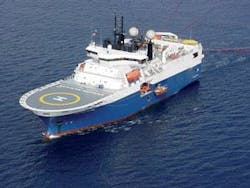Exploration picks up in Eastern Canada"s deepwater basins
Seismic signals probe a new frontier
Judy Maksoud
Special Correspondent
Seismic activity off Atlantic Canada hit an all-time high this summer, with WesternGeco alone putting three high-capacity vessels to work in the region. Investment off Newfoundland and Labrador is on a noticeable upswing. And the recent survey activity points toward exploration drilling in the near future.
WesternGeco, a joint venture between Schlumberger (70%) and Baker Hughes (30%), has the largest seismic vessel fleet in the world (Offshore, Worldwide Seismic Vessel Survey, March 2005). According to Doug Bogstie, marketing manager for Canada at WesternGeco, about 25% of the company’s high-capacity 3D fleet was operating in Atlantic Canada through the summer and into early fall.
The vessels working off Newfoundland included the M/VGeco Diamond, which arrived in mid May, and the M/V Western Neptune and M/V Western Patriot, which arrived in June.
The M/VGeco Diamondand M/VWestern Patriotare relatively new vessels and form part of Schlumberger’s conventional fleet, Bogstie says. The M/VWestern Neptune, which is nearly twice the size of the other two vessels, is part of the Q fleet, which carries WesternGeco’s proprietary Q-Marine data acquisition system.
Equipment carried on all of the vessels puts them in the top of the class according to Steve Whidden, WesternGeco’s country manager for Canada.
The surveys WesternGeco carried out for Chevron Canada and partners in the Orphan basin were scheduled to conclude late in September or early October. A separate survey for ConocoPhillips in the Laurentian sub-basin concluded in late August.
“WesternGeco is responsible for the ConocoPhillips survey from the physical survey through the final processed data, which will most likely be delivered late February of 2006,” Whidden says.
The Orphan basin survey data will most likely be delivered as a “quick look cube,” which requires less extensive processing than the data that will be delivered on the Laurentian sub-basin, Whidden says. The more rapidly delivered “quick look cube” data, which is delivered four weeks after the acquisition is complete, puts data in the operator’s hands much more quickly, he says, so preliminary well location decisions can be made much sooner.
“Robust processing capability onboard the vessels allows quite a bit of pre-processing to be done as the survey is being gathered. It also allows us to take a real-time look at the data quality and gives us a preview of some of the images that will appear in greater detail when the data is fully processed. That is a big advantage for our client,” Whidden explains.
All of the WesternGeco vessels that were working in Atlantic Canada this summer carry proprietary technology that provides imaging of the geological setting underneath the survey.
Regional challenges
Given the challenges presented in the area, the vessels certainly had their work cut out for them.
According to Bogstie, Atlantic Canada is not an easy place to work. For starters, the remote location stretches the logistical supply line to the limits of their capabilities. And the water depths in both the Orphan basin and Laurentian sub-basin reach 2,500 m.
In the Orphan basin, which is in the North Atlantic, icebergs are an issue and require close monitoring. Pack ice is also a concern that has to be considered when planning the survey, Bogstie says. Also, fog makes maintenance and repairs impossible and often compromises data gathering.
“Contingency plans are critical when working in an area like Atlantic Canada,” Bogstie says.”
Whidden agrees: “These are complex, difficult, and extensive areas in which to work.”
And to make matters even more complicated, there are geological issues in addition to environmental challenges.
Blaine Dow, Schlumberger business development manager for Atlantic and Eastern Canada, says the seafloor is one of the most significant geological concerns. The geology offshore Eastern Canada is characterized by an extremely hard water bottom or seabed, Dow explains. “What that does to the seismic data is trigger a lot of multiple interference, which can pose quite a challenge to data processors who have to try to remove that contamination from the seismic section.”
Contending with the water bottom is a critical issue. “When the seismic signal hits the hard water bottom, it reverberates within the water column itself. So the water bottom appears more than once in the seismic record,” Bogstie explains. “The reflection comes off the surface and back off the bottom and creates noise in a lot of cases where a client wants to see a geological image. The reverberation masks the seismic signal.”
With a hard interface, the change in signal velocity as it enters the water bottom is very high. And that creates a reflection. A slower change in velocity, which is what occurs when the seabed is softer, creates a lower coefficient and generates a cleaner signal.
Signal behavior is complex, but Whidden offers a simple analogy to explain the phenomenon created by the geology off Newfoundland.
“If you throw a ball onto a flat table, it bounces off the table at the same angle at which it was thrown. In the same way, a flat seabed allows for good energy transfer to the subsurface. With a very rugose seabed, on the other hand, the angle at which the signal bounces back is much more complex because the energy scatters. The ray path becomes very distorted, and the signal is unclear,” Whidden says.
“Undersea mountains in this region really throw a wrench into the process of trying to remove noise from the seismic image. It is a very serious problem, geophysically speaking, in both the Orphan basin and the Laurentian sub-basin,” he says.
Advances in technology
There was a lull in seismic activity offshore Atlantic Canada between 1990 and 1995, but in the last decade, things have changed dramatically. Between 1995 and 2005, Whidden says, WesternGeco has had 15 seismic vessels working in the region. And the most recently deployed vessels have gathered considerably more data.
In fact, improved data gathering methods have changed the face of the seismic surveys. In 1995, the M/VGeco Diamond gathered a survey offshore Newfoundland towing 18 km of streamer, Whidden says. This summer, the three vessels working in the region employed 156 km of streamer, a nearly three-fold increase per boat. “We are gathering much more information with today’s configuration than what we were capable of eleven years ago,” he says.
And today’s data is of considerably better quality, in part, Whidden says, because of WesternGeco’s Q-Marine technology.
The Q-Marine system is a single-sensor system with a calibrated marine source. Its performance differs from other streamer systems on the market, Whidden says, in the way it processes noise, the extra data that the acoustic sensors pick up in the course of recording the seismic signal.
“All seismic images include noise,” Whidden explains. “What the Q system does is minimize the noise that is recorded. And the noise that the system picks up is recorded such that it can be removed from the final product so that the resulting image is sharper. It is a high fidelity image,” Whidden says.
Another feature that makes the company’s data acquisition package different is steerable streamers.
“Like conventional towed marine streamers, our streamers can be steered vertically, but unlike others, ours can also be steered laterally,” Whidden explains.
Special “Q-Fins,” which are used to steer the cable, are positioned every 900 ft along the cable. The fins allow the streamers to be guided both laterally and vertically. Wings on the fins change their position in the water, ultimately controlling the position of the cable.
“They look like butterfly wings,” Glen Sansom, Schlumberger oilfield services general manager for Atlantic and Eastern Canada, explains. “They work like ailerons on an airplane’s wing.”
Because the Q-Fins communicate with the data acquisition system, they can be closely controlled from the vessel and can precisely place the streamers in the water. Streamer steering is a huge advancement in the seismic world because it allows much more control over positioning.
“Getting an accurate seismic image can mean big financial gain to operators,” Sansom says, “particularly in a region where a deepwater well can easily cost $100 million.”
4D surveys
Steerable streamers also improve the quality of 3D surveys conducted over the same area at a later time.
“In the longer term, the Q-Marine system’s streamer steering allows precise overshooting that can provide reservoir data once an area moves into production,” Whidden says. “Streamer steering enables us to position the streamers the second time we do a survey in the exact location they were in when we gathered the data the first time. That dramatically improves the quality of the processed data.”
With a conventional system, this isn’t possible because the sea conditions are never identical. “You can imagine,” Whidden says, “with a 6-km cable, a one- or two-degree difference in positioning means a 300-400 m difference in the data collected by the hydrophones at the end of the cable. But even more important to repeatability is the Q-Marine Calibrated System.”
Sansom agrees that 4D surveys are one of the biggest benefits of the Q system. “With a traditional seismic system, there needs to be five to ten years of oil production from a reservoir before any significant change can be detected. The quality of data that is possible with the Q-Marine system produces a detectable difference in as little as a year.”
Whidden believes a lot of operators are planning for 4D surveys when they contract for the Q-Marine survey over a given area. “Any Q-Marine survey, in effect, becomes a baseline 4D survey because of the positioning information we have and the calibration of the source,” he says.
High hopes
Sansom, who heads up the Schlumberger office in St. John’s Newfoundland, notes the flurry of seismic activity with optimism.
“Having the three vessels here and the big seismic surveys are a pretty clear indication of what is going to be happening in Atlantic Canada over the next few years with regard to exploration,” Sansom says. “Our understanding is that we could see additional exploration wells drilled here next year if the seismic is positive.”
This is an enormous rank wildcat area, Sansom says. “You can be sure there will be more seismic surveying. There is already significant interest in the region. And once you have interest, it seems to generate interest. There is a lot of acreage out there that is untouched.”•


